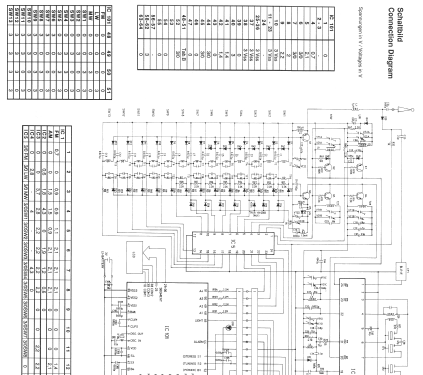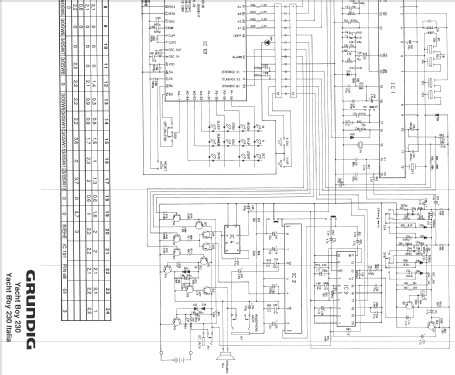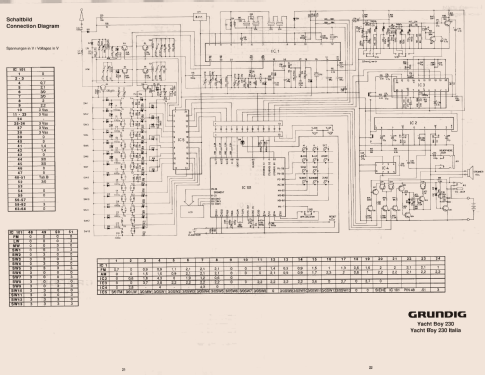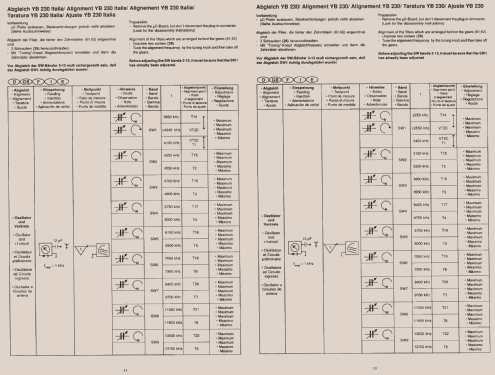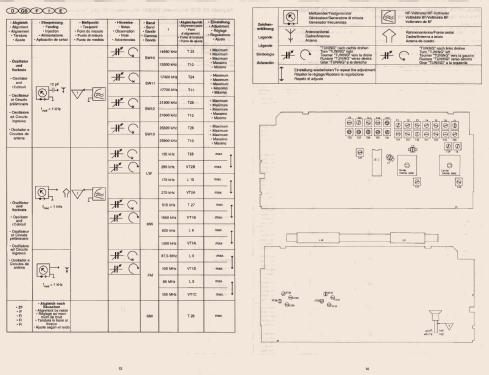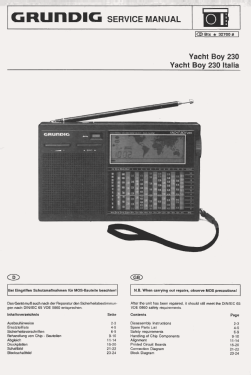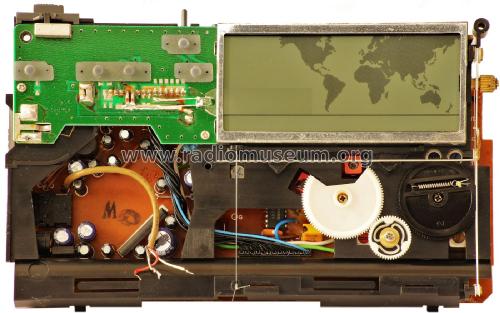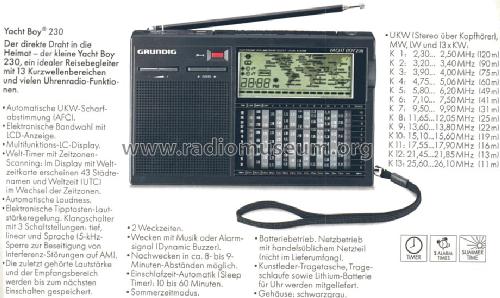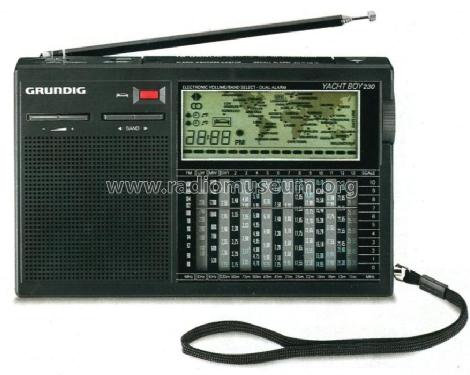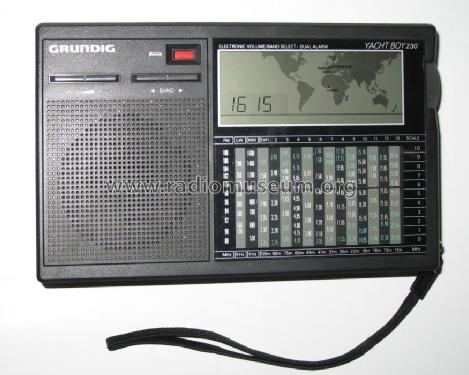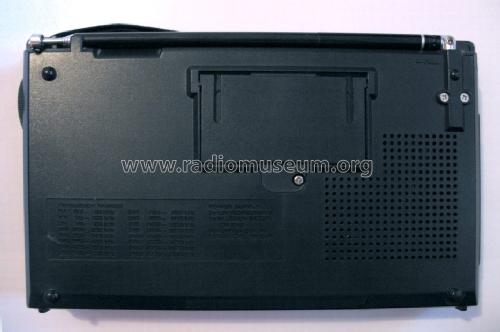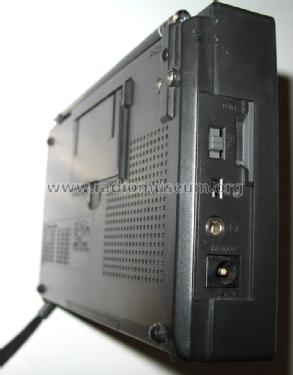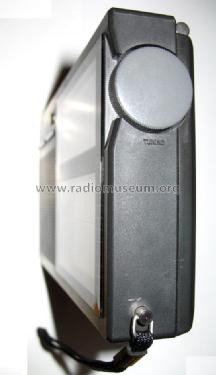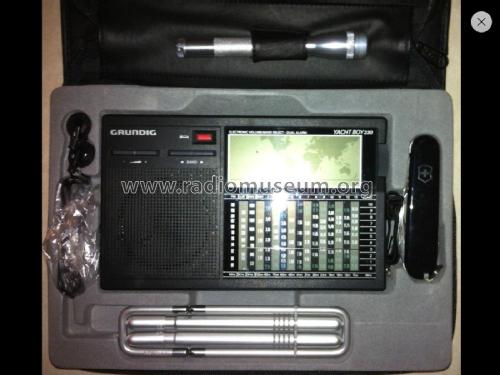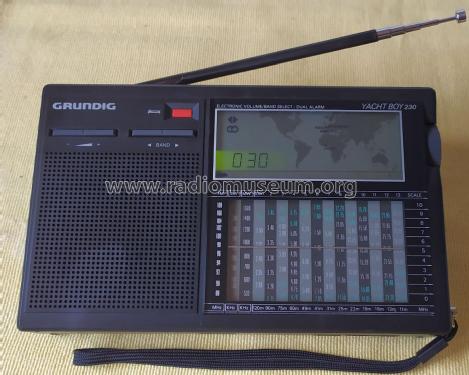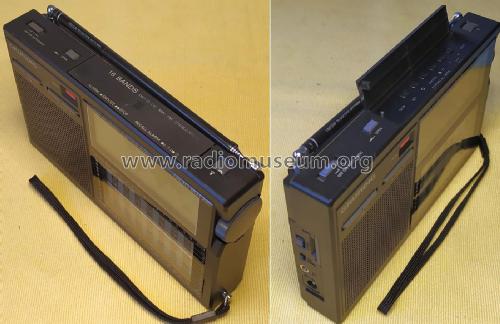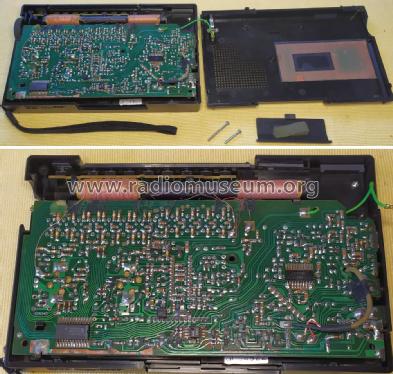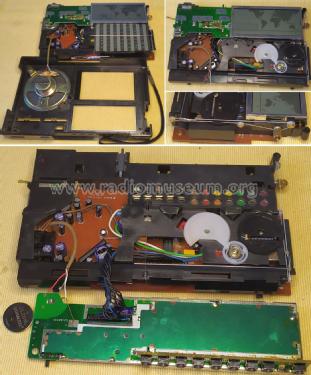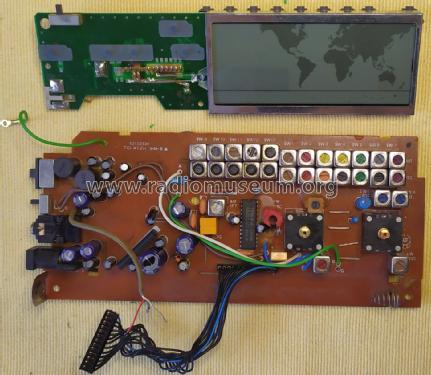Yacht-Boy 230
Grundig (Radio-Vertrieb, RVF, Radiowerke); Fürth/Bayern
- Country
- Germany
- Manufacturer / Brand
- Grundig (Radio-Vertrieb, RVF, Radiowerke); Fürth/Bayern
- Year
- 1989–1992
- Category
- Broadcast Receiver - or past WW2 Tuner
- Radiomuseum.org ID
- 97560
-
- alternative name: Grundig Portugal || Grundig USA / Lextronix
Click on the schematic thumbnail to request the schematic as a free document.
- Number of Transistors
- 19
- Semiconductors
- Main principle
- Superheterodyne (common); ZF/IF 455/10700 kHz
- Wave bands
- Broadcast, Long Wave, more than 2 x SW plus FM or UHF.
- Power type and voltage
- Batteries / addl. power jack / 3 × 1,5 & 3 / 4,5 Volt
- Loudspeaker
- Permanent Magnet Dynamic (PDyn) Loudspeaker (moving coil)
- Power out
- 0.6 W (max.)
- Material
- Plastics (no bakelite or catalin)
- from Radiomuseum.org
- Model: Yacht-Boy 230 - Grundig Radio-Vertrieb, RVF,
- Shape
- Very small Portable or Pocket-Set (Handheld) < 8 inch.
- Dimensions (WHD)
- 180 x 109 x 35 mm / 7.1 x 4.3 x 1.4 inch
- Notes
-
13 KW-Bereiche (11 - 120 m Band), LW, MW, UKW Stereo (mit KH);
LCD - Weltkarte, Uhr, 2 Weckzeiten; Elektronische LS Regelung + Bandwahl, 5kHz Sperre. 6 IC´s . Uhr Knopfzelle: 1×3 V (CR2016), Batterien vom Typ " Mignon ", AC Adapter Grundig 30-75 (4,5 V).Zum Betrieb ist die eingesetzte Knopfzelle erforderlich, ohne funktionsfähige Knopfzelle startet das Gerät nicht.
- Net weight (2.2 lb = 1 kg)
- 0.5 kg / 1 lb 1.6 oz (1.101 lb)
- Source of data
- -- Original prospect or advert
- Author
- Model page created by a member from A. See "Data change" for further contributors.
- Other Models
-
Here you find 6212 models, 5445 with images and 4211 with schematics for wireless sets etc. In French: TSF for Télégraphie sans fil.
All listed radios etc. from Grundig (Radio-Vertrieb, RVF, Radiowerke); Fürth/Bayern
Collections
The model Yacht-Boy is part of the collections of the following members.
Forum contributions about this model: Grundig Radio-: Yacht-Boy 230
Threads: 1 | Posts: 1
Despite being an analog receiver design, the management is done by a Sanyo LC5850-738 CMOS Single Chip 4-bit Micro-Computer with LCD Driver (IC101 on the PCB), that also supports the Clock, Alarm, Wolrd Map Time Zones, and Sleep functions.
The LC5850-738 receiver management functions are:
- RF Band selection with the help of a 74HC154 4-16 line decoder (IC5) whose output lines enables one of the 16 RF bands available in this radio model.
- Power ON/OFF control. This receiver design do not offer regulated power supply to the Management Processor, therefore the CR2016 3V is the single power source for both Clock and Receiver functions.
- Light control. Neither the Dial Scale nor the LCD feature ilummination, although the offered Light function allows to clearly see the clock time area with a nice green color thanks to the included single green LED (D101).
- Show Tuning and Stereo indicators on the LCD, by reading these signals from the Toshiba TA8122AN AM/FM Tuner IC.
The RF front-end uses discrete active buffer/amplifier devices together with pairs of tuned circuits, one transformer for RF tuning and the other for local oscillator, resulting in the use of a large number of RF transformers and switching devices for RF band selection. This is a good design choice imho.
The filtered RF signal is passed to the Toshiba TA8122AN AM/FM Tuner IC (IC1) that handles the RF amplification, local oscillators and mixers, as well as signal decoding with FM Stereo.
The dual channel audio signal is shaped for Tone Control, actively buffered and then passed to a Sanyo LC7534M Electronic Volume Control (IC3). A Toshiba TA7376P dual channel Audio Power Amplifier (IC2) will drive the stereo earphones while the internal 16 Ohm speaker appears to be connected in bridged mode.
The source of power supply (4.5VDC dry cells, or external adapter) is then used by:
- The IC3 thrugh a transistor switch (Q10)
- The LCD Clock zone green LED thrugh a transistor switch (Q17)
- The Sanyo LA5003M 3V LDO power regulator (IC4) thrugh a transistor switch (Q19).
- The transistor switches are controlled by IC101
- A smart protection circuit, built around a PNP power transistor Q18 is inserted when using a external power adapter.
- The regulated 3VDC from IC4 powers all the remaining devices, where some of them uses a 2.3VDC power source obtained by inserting a series diode (D34) at the output of IC4.
Jose Mesquita, 06.Aug.22
